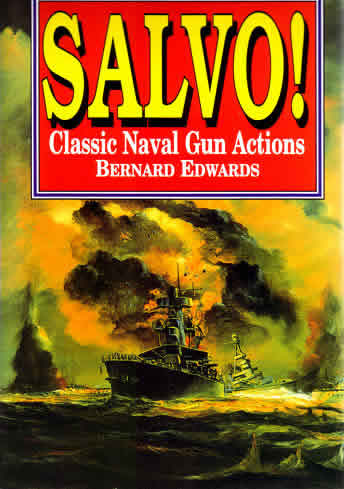
Salvo
Book review by Fred Lane
Edwards, B. Salvo: Classic naval gun battles. Naval Institute Press: Annapolis 1955. 184pp, 36 photographs, track charts, bibliography and index. US$23.36. (Cheaper new and secondhand books may be found at remainder counters and on the internet.)
In yet another gripping book, CAPT Bernard Edwards RN describes 18 classic naval gun battles that date from the Yalu River action in 1894 to the Battle of the Surigao Strait in 1944. This book is one of a series of a dozen or more by the same author, all describing naval actions and the ways of the seafarer. In this instance, he has chosen well. His battles range from massive fleet engagements, such as the 1915 Dogger Bank battle, to the single ship Sydney I versus Emden engagement in 1914 and the mysterious Sydney II versus Kormoran action in 1941. As befits a navigator, his many track charts clearly illustrate the various battles without extraneous clutter.
Edwards explains in his introduction that before the Yalu River action, the all-important naval gunnery tactic was not much advanced from the broadside with muzzle-loading cannon, often at ranges of 100 yards or less. The RN-trained Japanese at Yalu, in their Dreadnought-era ships, defeated a strong Chinese fleet supporting an invasion force. They used modern guns and fired them at much longer ranges. It might be noted, however, that the Japanese fleet withdrew, not because it had sunk all the Chinese warships, but because it was running out of ammunition.
Coronel and Falklands
On the other hand, the overwhelmingly decisive battles of Coronel and the Falklands Islands in 1914 resulted in the virtual annihilation of the enemy fleets. First the British, under RADM Cradock off Coronel, lost the heavy cruisers Good Hope and Monmouth in a 40-minute action on 1 November 1914 without inflicting serious damage on any German ship. Then the victorious RADM Von Spee’s German squadron met its nemesis off the Falklands, losing both battlecruisers and two of his three cruisers at the hands of a vastly superior Royal Navy fleet commanded by RADM Sturdee. Dresden was the only German cruiser to escape and even her end came three months later when HMS Kent and Glasgow caught her coaling in the Pacific.
In a well written chapter about SMS Königsberg‘s blockade and destruction (Newsletter 68, March 2007, pp 11-18) there is an excellent description of the German cruiser’s successful Zanzibar sortie where she destroyed the anchored British cruiser HMS Pegasus.
Edwards confirms that on 6 July 1915 this Rufigi Delta “operation entered the history books [as] the first combined air-sea operation.” He also confirmed that the spotter planes were “obliged to fly low and were forced to take violent evasive action to avoid the fierce concentration of small arms fire coming up at them,” and that without “aerial observation [the monitor’s] bombardment was a waste of ammunition.” These important points are frequently overlooked in modern descriptions of the action.
Last big gun battle
Edwards describes the last big gun battle, the Surigao Strait slaughter, 25 October 1944 when, in a series of interconnected bloody battles, the Japanese lost two 36,000-ton battleships, two heavy cruisers and three destroyers. The Allied force lost one PT boat and one destroyer damaged by friendly fire. In one 20-minute period, RADM Oldendorf’s ships, which included five battleships and eight cruisers, fired no less than 3,250 shells at the approaching Japanese force.
The last significant surface ship vs surface ship action of WW II, and perhaps of all time, as Edwards observes, was the successful attack by five RN destroyers led by CAPT Manley Power on the Japanese cruiser Haguro, 16 May 1945. Haguro sank after three almost simultaneous torpedo hits.
Air-launched guided missiles, starting with the German Henschel Hs 293A-1 success on 23 August 1943 and the Ruhrstall/Kramer SD 1400 Fritz-X a few days later in WW II, add an entirely new dimension to the face of this kind of naval battle.
